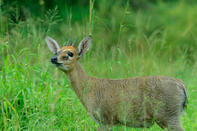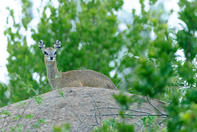Marking Territories
Klipspringer will defend their isolated resources by chasing intruders away but are seldom aggressive to one another and the presence of an animal standing conspicuously on a high point is often sufficient to repel unwanted visitors.

Sometimes temporary associations of a number of family groups will form in areas where there are particularly good feeding grounds and klipspringer may even leave the rocks to exploit resources on nearby flats.
Should any disturbance occur, each unit will flee back to the safety of its rocky retreat. In conjunction with the visual statue-pose display, klipspringer demarcate their territories by creating copious dung piles throughout their turf most especially along boundaries.
They horn bushes and take care to deposit tarry secretions from the preorbital gland, an obvious naked black slit in front of eyes, on the ends of twigs by inserting the twig right into the gland. The male marks most frequently and when the female marks, her mate will over-mark her secretion to reinforce it. This is also believed to reinforce pair-bonding.
Whistle Snort Alarm

Klipspringer mostly have the advantage of seeing danger approach from afar.
They respond to distant threats by freezing and allowing their colour and rounded-back shape to blend them into their surrounds. They may resort to using a whistle-snort alarm, which can be heard up to 0.7 km away to alert the partner or offspring of danger.
The pair sometimes duet this high-pitched sound repetitively and direct it at the predator so that it realizes that the element of surprise has been lost and pursuit is not sensible. Klipspringer can easily outrun most predators in their own habitat.
By Megan Emmett